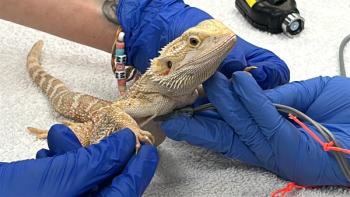
Using cytology in exotic mammal diagnoses (Proceedings)
Cytology is a diagnostic tool that may be utilized on a daily basis in veterinary practice as it allows for quick answers with minimum of expense. The goal as a veterinary practitioner with a special interest in cytology is not always to make a definitive diagnosis based on cytologic results, but to help narrow the number of diagnoses on the differential list and give information on prognosis and help direct the formulation of a diagnostic and treatment plan.
Cytology is a diagnostic tool that may be utilized on a daily basis in veterinary practice as it allows for quick answers with minimum of expense. The goal as a veterinary practitioner with a special interest in cytology is not always to make a definitive diagnosis based on cytologic results, but to help narrow the number of diagnoses on the differential list and give information on prognosis and help direct the formulation of a diagnostic and treatment plan. The presentation is designed to give a realistic view of day-to-day cytology as seen through the eyes of the practitioner at the bench microscope.
Diagnostic cytology is both a science and an art. The science is in the interpretation, requiring a familiarity with normal anatomy and histology and an understanding of pathology. The art is the collection and preparation of a diagnostic sample. That favorite utterance of the clinical pathologist must be heeded: "The results are only as good as the sample".
The cytologist must first define the cell population(s) present and then decide whether the collected specimen is primarily inflammatory, hyperplastic, a reactive lesion, neoplastic or normal. Further questions to be answered include: If inflammatory, does the specimen represent acute or chronic inflammation? Is there evidence of infectious organisms? If fluid from a body cavity is being analyzed is the effusion a transudate or an exudate? Is the mass or enlarged organ just aspirated reactive, hyperplastic or neoplastic? If neoplastic, are there criteria for malignancy? These are some of the questions the practitioner is trying to answer when interpreting cytology samples.
What makes cytology such wonderful diagnostic tool is the amount of information that can be gained in a matter of minutes. With a strong knowledge of cytology the veterinarian can obtain a quick sample that will help direct the focus of the diagnostic workup or determine overall case prognosis, many times while the client is waiting. In addition, the investment needed to add this modality to the practice setting is minimal and utilizes equipment already present in most veterinary hospitals; needles and syringes, cotton swabs, scalpel blades, glass slides, a good differential stain and microscope with oil immersion lens. The following are suggestions for improving cytological preparation and simplify interpretation in the private practice setting.
• Have two sets of stain; dirty for obviously contaminated specimens and clean for effusions, fine needle aspirates (FNA) of masses, and other specimens without obvious contamination.
• Utilize two microscopes at the lab work station; one for "dirty" samples such as your fecal and urine analysis, and a higher quality microscope reserved for reviewing cytology specimens.
• Filter stain through paper towels or filter paper twice weekly to help remove bacteria and other obvious contaminants and change stain completely on a monthly basis.
• Use a hair dryer on the low to medium heat setting for quick drying of slide specimens prior to immersion in stain fixative.
• Oil immersion field is necessary for cytologic interpretation.
• To aid in-hospital cytology interpretations; keep representative slides from interesting cases to review once you receive the pathologist's report.
• Be gentle in the collection of specimens; avoid strong, intense aspiration when performing FNA's in order to prevent cell trauma and bleeding into specimen.
• Be gentle in sample preparation; a light touch as the specimen is smeared across the glass slide.
• Bacteria within the cell are real. Look for concurrent secondary cell degeneration. Bacteria outside the cell could be from contamination.
• Carcinomas are of epithelial cell origin and generally exfoliate well on FNA sampling with clusters of round to oval cells visible.
• Sarcomas are of connective tissue origin and generally do not exfoliate well on FNA sampling with few individual elongated spindle shaped cells seen.
Sampling
The most frequently used sampling technique is the fine needle aspirate. The technique is in general noninvasive and can be used to take samples from local masses and internal organs. In the exotic mammal a 3 or 6 cc syringe with a 22 or 25 ga needle is most commonly used. Manual stabilization of an external mass for aspiration may require sedation in the difficult to restrain exotic mammal. For sampling of internal organs most patients benefit from the administration of preanesthetic agents including sedatives and/or opioid analgesics. If additional restraint is required patients can be masked down with isoflurane or sevoflurane to complete the quick procedure. The author prefers to insert the needle into the mass followed by application of gentle negative pressure while redirecting the needle several times in order to obtain a representative sample. Aspirates of solid masses and organs rarely fill more than the bore of the needle and nothing may be visible in the needle hub and syringe. After withdrawal, the needle is removed, the syringe is filled with air and the needle reattached. The aspirated contents can then be expelled onto several slides and smeared for a thin, preferably single cell layer preparation. Samples are prepared by laying a clean slide on top of the sample and drawing the two slides apart.
For thoracic or abdominal effusions a 22 ga butterfly catheter with an attached 12 cc syringe is the preferred method of draining the effusion and obtaining a diagnostic sample. Many exotic companion mammals with body cavity effusions are depressed and manual restraint may be adequate. For analgesia, local anesthetics (Lidocaine 2% AgriLaboratories, St Joseph, MO, USA, 1 mg/kg) may be instilled into the area of needle insertion, which is then clipped and surgically prepped. The method of slide preparation is dictated by the cellularity and protein content of the fluid sample. Low protein concentration renders cells extremely vulnerable to rupture. A Statspin™ ( StatSpin, Inc., Norwood, MA, USA) or other cytospin centrifuge will help decrease cell trauma and speed the processing of samples. The author prefers to make slides of both the fluid sample as collected and a sample of centrifuged fluid sediment. If the sample is of low cellularity the sediment sample may be more informative whereas for effusions with high cellularity a direct fluid smear usually provides a representative number of cells for analysis. Either way the author has both samples processed and ready to review, which can save time.
Other techniques for obtaining cytology samples include tissue impression smears, tissue scrapings with a scalpel blade that are subsequently smeared on a glass slide, and cotton swab smears from skin or ear lesions.
Staining
The staining of a specimen is the final step in the art of cytology. In veterinary medicine the two stains used most extensively are the new methylene blue (NMB) and the Wrights/ Romanovsky-type stains.(1) Romanovsky-type stains are preferred by the author, because of their ease of use in the practice setting and practitioner familiarity with cell morphology that results from their common application in staining peripheral blood smears. The author was introduced to cytology specimens that were stained with Diff-Quik® (Diff-Quik® Differential StainSet- Fisher Scientific Intl, Schwerte, Germany) and therefore prefers this simple and fast staining technique. The staining times for Diff-Quik® stain solutions may need to be adjusted as required by the thickness of the cytological preparation and the freshness of the stain.
Cytologic interpretation
Components of Inflammation
Inflammatory lesions are characterized by a large number of neutrophils, lymphocytes, plasma cells, eosinophils, monocytes or differentiated macrophages. Differentiation of the types of inflammation (table 1) is important in etiologic diagnosis. For example bacterial infections would most often be represented by acute inflammation; mycotic or foreign body reactions by granulomatous inflammation; and parasitic or allergic (antigen-antibody reactions) will often result in eosinophilic inflammation. (2)
Table 1. Cytologic components of inflammation
Tissue hyperplasia
Tissue cells in areas involved with local inflammation are often hyperplastic or reactive. The recognition of hyperplasia depends heavily upon a sound ability to recognize normal tissue because hyperplastic cells strongly resemble normal cells. Differentiation is primarily based on the fact that hyperplastic cells exhibit the features of increased cell growth and reproduction represented by cytoplasmic activity including more abundant and basophilic cytoplasm (increased RNA activity). Nuclei may be larger than those of normal cells with more predominant nucleoli. An important feature is that the nuclear to cytoplasmic ratio remains normal.
Cytology of fluid accumulations (effusions)
Differentiate transudates from exudates based on fluid protein content and cell populations. (Table 2) Define the population of cells present and compare these cells to those found in normal fluid of the body cavity from which the sample has been obtained. Decide whether the cells in the fluid accumulation are normal, noninflammatory, the result of inflammation or the result of neoplasia. If inflammatory is the effusion septic (bacteria present) or nonseptic? Note that macrophages of fluid accumulations are generally large cells with abundant vacuolated cytoplasm and irregular margins. Vacuoles often contain infectious organisms or phagocytized debris or cells.
Table 2. Characterizing effusions based on protein content and cell populations (3)
Malignant effusions
Malignant effusions are delineated from other effusions by the presence of tumor cells. Malignant effusions may show some of the characteristics of noninflammatory or inflammatory effusions but are usually exudative and inflammatory. If the neoplastic process has seeded the serosal surface, tumor cells will usually be abundant in the fluid. If the neoplastic growth is subserosal and has not ulcerated through the mesothelial lining, no or only a few tumor cells may be present. Malignant effusions can be quite bloody and if necrosis and secondary inflammation occur, neutrophil numbers will be elevated. In addition, tumorous involvement of the serous lining often causes hyperplasia and thickening of the mesothelium. It is important to recognize that reactive mesothelial cells may develop to mature macrophages and be seen singly or in clusters. These reactive mesothelial cells demonstrate an intense cytoplasmic basophilia that decreases in intensity with cell maturity, nuclei that are less hyperchromic than normal mesothelial cells, and the normal eosinophilic brush border may evolve into denser foot processes. It is important to differentiate these reactive mesothelial cells from neoplastic cells, especially carcinomas and adenocarcinomas, which may be associated with modified transudates.
Criteria for Malignancy
A cytological diagnosis of malignancy requires a minimum of 3, preferably 4, criteria of malignancy. (Table 3) Histopathology is the preferred method of making a distinction between benign from malignant. Cytologic features can be used to help differentiate epithelial, mesenchymal and discrete/round cell neoplasms. (Table 4) Hyperplastic tissue, characterized by increased cell growth, may be difficult to cytologically differentiate from neoplastic tissue. (Table 5)
Table 3. Cytologic criteria for malignancy
Table 4. Cellular features of the 3 basic types of neoplasms (2)
Table 5. Differentiating granulomatous and reactive hyperplasia from malignancy
References
Meyer DJ. The management of cytology specimens. Comp Con Ed. 1987, Vol 9 (1), 10-17.
Feldman B, Fisher PG. Proceedings; Diagnostic Clinical Cytology. Virginia-Maryland Regional College of Veterinary Medicine, Blacksburg, VA USA 1997.
Meyer DJ, Franks PT. Effusion: classification and cytologic examination, Comp Cont Ed, 1987 Vol 9 (2), 123-128.
Suggested reading
Garner M. Cytologic Diagnosis of Diseases of Rabbits, Guinea Pigs, and Rodents. Veterinary Clinics of North America, Exotic Animal Practice. Elsevier, 2007; 10(1).
Campbell T, Ellis C. Avian and Exotic Animal Hematology and Cytology. Blackwell Publishing, 2006.
Baker R, Lumsden JH. Color Atlas of Cytology of the Dog and Cat, Mosby, 1999.
Perman V, Alasker RD, Riis RC. Cytology of the Dog and Cat, AAHA press, Denver, CO. 1979.
Newsletter
From exam room tips to practice management insights, get trusted veterinary news delivered straight to your inbox—subscribe to dvm360.






